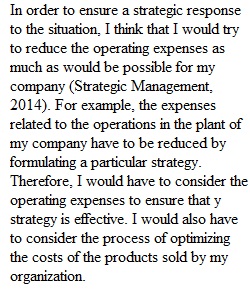


Q Learning Activity #1 In the following case, assume that the company is a manufacturer of sports watches and other wearable electronic sports technology. A new entrant from China has just entered the market. The new competitor offers low prices, good quality, and good service. You determine that the brand could start to become very well established internationally with one year. Although the breadth of the new entrant’s product line is small (four products at four different price points), it will be possible for it to offer a full line of products (about 8, ranging from low-end to luxury products) within two to three years. Clearly, the new entrant has upset the balance of your firm and those of your competitors. (In this example, you could understand the product as anything from perfume to automobiles, from jewelry to athletic shoes.) The new entrant offers prices that are about 20% lower than the market currently sees. You believe that its operating expenses are lower and that it wishes to recover a lower profit than is customary in this industry. The company’s strategy is to “buy in” to the market and then recover over time through volume. It is a similar strategy that your firm used 10 years ago to enter into this market. So, the question is: how do you respond strategically? What areas of the firm must be cut? How do you prioritize the elements of the company and retain current operations in one area and cut in others? To say, we need to reduce our costs by X% across the board is not an answer, because it means nothing without details behind it. In considering your response to this problem, identify any product that you are familiar with and try to analyze what you could do without: do you need after-sales service? Do you put a high value on customer relations? Is quality always important? Please note, as with the other question this week, there is no one right answer. All products have different mixes of activity and are perceived differently by consumers.
View Related Questions